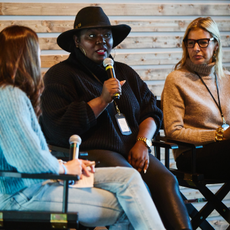

The pandemic has catapulted capitalism into a future unknown—and the gig market into center focus. Pandemic-related layoffs have created intense need and competition for contract jobs, and women especially are on the market: During March and April, 11.7 million women lost their jobs, compared with 9.6 million men. But the freelance space, one of the few sectors to thrive as a result of the national crisis, saw a surge of openings. This year, two million people joined the nearly 57 million Americans who already called themselves freelancers. And the shift doesn’t show signs of slowing. So if you’re a recent free agent, don’t panic. We’ve got you: Here, our guide to going freelance.
In mid-March, Samantha Sands, 23, moved from the Bay Area to San Diego for her new job as a tech publicist at a small agency. Just three days after starting, Sands began working from home. A week and a half later, she was told her hours would be cut because clients were pausing and canceling services. Then, two days after that, she was terminated—becoming one of the more than 22 million Americans who have lost their job as a result of the COVID-19 pandemic.
Then in June, Sands stumbled upon an interesting job listing while perusing LinkedIn and Indeed: her former position. But instead of being a full-time role, it was a contract gig with lower compensation. “I can understand it, but it was also frustrating,” she says. “They could have had a conversation with me.” Now she’s working freelance elsewhere while interviewing for full-time positions. “So many companies don’t know what’s going to happen in the future, so they’re just looking for contractors until the country is stable again,” she adds.
Sands’s situation is not unusual: About one third of organizations are eliminating full-time employees in favor of contractors as a cost-saving measure, according to research firm Gartner. As companies restructure to accommodate falling revenue, workforce cuts seem easy: Switching a portion of their employee base to freelance helps businesses save on salary costs and pricey benefits.
But once, freelancers did have a few perks that nine-to-fivers didn’t: Usually, they could work from home. They could design their own schedules. In most cases, they could pick their assignments instead of toiling at the mercy of a needy boss. In our current remote world, pretty much everyone works this way. (Well, some of us still have a needy boss.) The blurred new reality can be bad for freelancers: An employer can have two workers doing essentially the same job, and sometimes what differentiates them is not what they turn in or the gains they make for the company but rather their earnings and insurance status, potentially putting a contractor in a disadvantaged position. It is the employer’s responsibility to classify workers correctly and stick to the boundaries of a contractor or an employee position, says Michelle S. Strowhiro, a partner at McDermott Will & Emery and co-lead of the firm’s COVID-19 Employment Task Force. Unfortunately, especially now, that might not always happen the way it ideally should.
According to Elisabeth Reynolds, executive director of MIT’s Task Force on the Work of the Future, the pandemic also exposes what’s known as the shadow labor market—roles without benefits and rights that may skirt taxes and labor regulations. The social safety net for these folks (including contract, freelance, and front-line workers who power the gig economy) is weak, despite some short-term government protections, including those offered through the federal stimulus bill. “Those workers are some of the most vulnerable workers in society when it comes to unemployment shocks,” Reynolds says.
The economic crisis aside, for many, the jump to freelance isn’t forced; it’s a choice made to enhance flexibility. However you got here, Rafael Espinal, executive director of the Freelancers Union, insists that it’s time for the government to recognize this cohort as a priority. “We are in a period of time when the freelance workforce is regarded as ‘the future of work,’ ” he says. “It is the present reality for many individuals in this country.”
Stay In The Know
Marie Claire email subscribers get intel on fashion and beauty trends, hot-off-the-press celebrity news, and more. Sign up here.
Read the Rest of our Guide to Going Freelance:
This story originally appeared in the Winter 2020 issue of Marie Claire.
Jenna is a freelance journalist, focusing on topics like health, wellness, dating, relationships, beauty, and lifestyle. She's the author of The Love Gap: A Radical Plan to Win in Life & Love, a dating guide for modern women trying to navigate today’s complicated romantic landscape.
-
 Chrissy Teigen Went Instagram-Official With Meghan Markle's Jam
Chrissy Teigen Went Instagram-Official With Meghan Markle's JamA GRID post, y'all.
By Iris Goldsztajn Published
-
 Olivia Rodrigo Finds the Perfect Spring Dresses at Reformation
Olivia Rodrigo Finds the Perfect Spring Dresses at ReformationShe's worn the brand twice in the past week.
By Julia Marzovilla Published
-
 Curiously, Just as Meghan Markle Sends Samples of Her New Strawberry Jam Out, the Buckingham Palace Shop Starts Promoting Its Own Strawberry Jam on Social Media
Curiously, Just as Meghan Markle Sends Samples of Her New Strawberry Jam Out, the Buckingham Palace Shop Starts Promoting Its Own Strawberry Jam on Social MediaThe clip promoting the Buckingham Palace Shop’s product—we cannot make this up—is set to Mozart’s “Dissonance Quartet.”
By Rachel Burchfield Published
-
 Peloton’s Selena Samuela on Turning Tragedy Into Strength
Peloton’s Selena Samuela on Turning Tragedy Into StrengthBefore becoming a powerhouse cycling instructor, Selena Samuela was an immigrant trying to adjust to new environments and new versions of herself.
By Emily Tisch Sussman Published
-
 This Mutual Fund Firm Is Helping to Create a More Sustainable Future
This Mutual Fund Firm Is Helping to Create a More Sustainable FutureAmy Domini and her firm, Domini Impact Investments LLC, are inspiring a greater and greener world—one investor at a time.
By Sponsored Published
-
 Power Players Build on Success
Power Players Build on Success"The New Normal" left some brands stronger than ever. We asked then what lies ahead.
By Maria Ricapito Published
-
 Don't Stress! You Can Get in Good Shape Money-wise
Don't Stress! You Can Get in Good Shape Money-wiseYes, maybe you eat paleo and have mastered crow pose, but do you practice financial wellness?
By Sallie Krawcheck Published
-
 The Book Club Revolution
The Book Club RevolutionLots of women are voracious readers. Other women are capitalizing on that.
By Lily Herman Published
-
 The Future of Women and Work
The Future of Women and WorkThe pandemic has completely upended how we do our jobs. This is Marie Claire's guide to navigating your career in a COVID-19 world.
By Megan DiTrolio Published
-
 Black-Owned Coworking Spaces Are Providing a Safe Haven for POC
Black-Owned Coworking Spaces Are Providing a Safe Haven for POCFor people of color, many of whom prefer to WFH, inclusive coworking spaces don't just offer a place to work—they cultivate community.
By Megan DiTrolio Published
-
 Where Did All My Work Friends Go?
Where Did All My Work Friends Go?The pandemic has forced our work friendships to evolve. Will they ever be the same?
By Rachel Epstein Published
